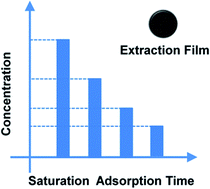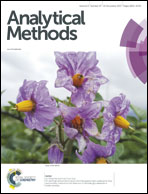Self-assembled activated carbon nanoparticles for reliable time-discretized quantitative surface-enhanced Raman spectroscopy†
Abstract
Quantitative analysis is an important aspect of surface-enhanced Raman spectroscopy (SERS). However, due to changes in the enhancing performance of SERS substrates, it is difficult to obtain reliable analysis results. In this work, a reliable quantitative method is introduced to overcome this problem by an external standard method. To achieve the external standard method, a self-assembled film of activated carbon nanoparticles is first prepared at the air/liquid (KCl aqueous solution) interface. Next, the activated carbon film transferred onto the surface of a Teflon slice (extraction film) is dipped into a high concentration of analyte to achieve reliable saturated adsorption, and the extraction film under saturated adsorption is called the reference (external standard). The uniformity is very good in one extraction film and thus the extraction film is cut into halves (used to prepare the determinand and reference) to eliminate deviation of different batches. The saturated adsorption time of the extraction film is different for different concentrations of analyte and the concentration can be therefore quantified by saturated adsorption time. Because the enhancing performance of the SERS substrate is almost unchanged in a short time and all of the SERS measurements are conducted at a similar measurement condition (saturated adsorption), the SERS intensity of the determinand and reference is almost the same under saturated adsorption. The SERS intensity of the determinand normalized by the reference is therefore very stable and uniform (approximately equal to “1” under saturated adsorption). The preparation conditions of the determinand and the reference are the same except for the concentration of the analyte, thus the interference can be eliminated by an external standard method. Any perturbations caused by the performance change of colloid substrates can be therefore effectively overcome. Moreover, the saturated adsorption time of the extraction film for different concentrations of analyte has a large time margin. This method is very simple and the cost is very low. Based on this method, a concept of time-discretized quantitative SERS (TDQ-SERS) is introduced. Thus, a reliable, simple, and economic quantitative SERS technique can be achieved.



 Please wait while we load your content...
Please wait while we load your content...